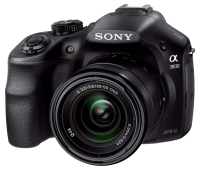Sony A3000 gallery photos posted: Can this low-cost champ deliver high-end DSLR results?
posted Monday, December 2, 2013 at 10:39 AM EDT

We just published our first batch of gallery images for our review of the Sony A3000, the company's new entry-level, E-mount mirrorless model that looks like a mini-DSLR. We're pretty enthusiastic about the results, especially considering the camera's low (US$349) cost. Though it lacks its predecessor's Translucent Mirror and Alpha lens mount, the Sony A3000 is essentially a replacement for the now-discontinued Alpha A37 and forms the new entry-point to the Alpha A-series line -- despite the fact it uses E-mount lenses -- and a rival to the Sony NEX-3N. At the heart of the new camera resides a 20.1 megapixel, APS-C-type EXMOR HD CMOS sensor, which provides a considerable imaging bang for the buck.
As our reviewer Jason Schneider says, "the A3000's overall picture-taking performance is truly impressive, irrespective of price. Based on shooting a wide variety of subjects at light levels ranging from dim, dark interiors to outdoor scenes in brilliant sunshine, I found the camera's imaging performance to be consistently excellent at ISO settings ranging from 100 to 800. Photos exhibit very good detail, definition, color saturation and very low noise even at ISOs in the 1600-6400 range."
In addition to browsing through our gallery of new real-world photos, make sure to use our Comparometer™ to pit images taken by the Sony A3000 against the Sony A37, Sony NEX-3N or any other camera we've ever tested.
Check out our Sony A3000 gallery images, as well as our Sony A3000 First Shots* (if you haven't already), and then read our first impressions Sony A3000 review for more info about this new mirrorless camera's features and specs. Stay tuned for our in-depth, complete A3000 review in the coming weeks.
* Use our Still Life target images to look for detail (tone-on-tone, fine, highlights, shadows), as well as noise suppression, white balance, color accuracy and color shape retention. Use the Multi Target images to look for lens sharpness, chromatic aberration, color handling, contrast vs. detail vs. noise, and moiré. Both targets are shot at the full range of ISOs to show how many of these factors change as ISO rises. You may also want to look at our Indoor and Outdoor Portrait targets to further investigate color handling, white balance, detail, contrast and more.
